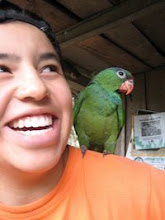Every day at my work brings something new. Some days I´m at the office and other days I´m visiting our community groups. At the moment I am involved with two projects. The first revolves around breeding corn, while the second is focused on various aspects of organic agriculture.
The goal of our corn project is to cultivate and breed varieties of maíz criollo, or “creole” corn, in order to decrease dependency on commercially produced hybrid corn and the chemical fertilizers, pesticides and herbicides that come with it. Maíz criollo really just means the local varieties of corn that have been domesticated and selectively-bred to suit human needs for thousands of years in Mesoamerica. Yes, corn is a completely domesticated plant; at this point in its evolution it is dependent on humans for survival.
In El Salvador, corn gets planted in the month of June to take advantage of the rainy season. It grows to around 8 feet tall, reproduces through wind pollination, and develops a corn cob containing the seeds (grains) which are harvested in November for consumption. You can make many dishes out of the different varieties of corn (for example popcorn versus sweet corn) and out of the different stages of corn growth. In August it is elote season, when the grains reach the ripeness necessary for corn on the cob and atol, a thick corn drink served sweetened and very hot.
What this means in terms of creole corn breeding is that we have to plan ahead a bit. At certain points in the agricultural cycle we choose plants, then cobs and then seeds that show favourable characteristics. These include greater harvest yield, favourable plant size, demonstrated plant health, and so forth – the good traits that we want the next generation of corn plants to have. We store the final selection of seeds for planting next year.
The organization that I work for supports 4 different community groups with technical training and raw materials to be put to use in collectively farmed plots of land. The idea is that at each of the fields we use only organic agricultural techniques (no chemicals!) to cultivate the corn, and thus demonstrate the possibilities and benefits of this kind of agriculture. My job involves a bit of everything: providing technical support in the field, recording the whole process digitally (photos and field notebook), and writing 2 manuals on corn breeding techniques. One is specifically geared for use by an agronomist and the other for use by a farmer. I really love the hands-on aspect of agricultural work, and the fact that I learn something new every day. My coworkers are extremely knowledgeable and a lot of fun. Right now we are waiting for the grains to finish drying and maturing so that they can be harvested very soon.
Subscribe to:
Post Comments (Atom)

No comments:
Post a Comment